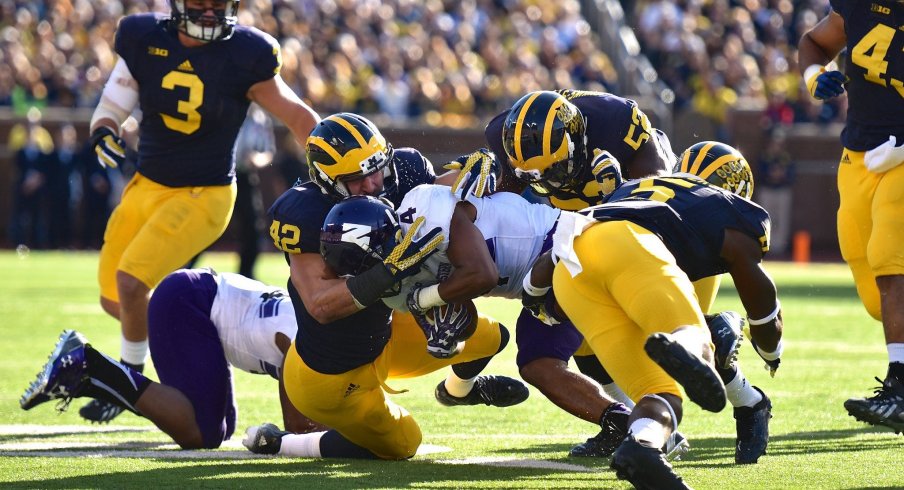As a former quarterback, Jim Harbaugh has been known more for his offensive mind throughout his tenure as a head coach at the University of San Diego, Stanford, and the San Francisco 49ers. Yet his teams have always featured excellent defenses, and although he's in just his first year running the program in Ann Arbor, his unit is already playing at a high level on that side of the ball.
After taking over a group that had performed well under the tutelage of former coordinator Greg Mattison, Harbaugh kept Mattison on as defensive line coach while adding former Florida coordinator D.J. Durkin to run the unit. Durkin saw success almost immediately with his aggressive, man-to-man defense that is rarely seen at the college level due to its complexity.
Unlike the 'quarters' look that Ohio State, Michigan State, and many other college programs run that feature two deep safeties, Durkin's defense regularly lines up with only one. Often using 'nickel' personnel with an extra defensive back on the field in place of a third linebacker, the Wolverines like to line up in one-on-one coverage on the outsides, letting the free safety play center-field behind them.

Although his squad often uses personnel designed to take away the passing game, the Wolverine defense has been very good against the run this year, ranking fourth nationally in rushing yards-allowed. Linebackers Joe Bolden (#35) and Desmond Morgan (#3) lead the team in tackles, but the 'overhang' players such as strong safety Jabrill Peppers (#5) are regularly involved in stopping the run, aggressively stepping up when they read a running play.

Though UM appears to have only six players in the box at the snap, Bolden and Peppers quickly close in on the ball-carrier from their initial alignment in the alleys, giving the defense eight defenders at the point of attack. Even though the offense has called for 'Power' giving them an extra blocker on the play-side, they're still out-manned.
But though Durkin's run defense looked nearly impenetrable early in the year, cracks in the facade have begun to show as the Wolverines have hit the back half of their schedule.
| Month | Yds-Per-Rush | Rush Yds-per-game | total yds-per-game |
|---|---|---|---|
| Aug/Sep | 2.56 | 82.00 | 203.8 |
| Oct | 2.26 | 67.25 | 280.0 |
| Nov | 4.63 | 168.33 | 319.7 |
After handling the non-conference schedule with ease, some conference opponents like Minnesota and Indiana have found success, specifically when running from spread formations.
One big reason for the downturn in results has been the absence of nose tackle Ryan Glasgow. Though he didn't stuff the stat sheet in nine games before suffering a season-ending shoulder injury, the former walk-on anchored the front of the UM defense by drawing double-teams that kept Morgan and Bolden free to make tackles unblocked.
Without his presence, opponents have been able to get to the second level and seal off those linebackers. In this example against Indiana, we can not only see new nose tackle Maurice Hurst (#73) get pushed backward on this split-zone inside run, but we see blockers get their hands on both inside linebackers, forcing the free safety to make a tackle after a big gain.

When the UM defensive line struggles to get any push or penetration, outside runs have gashed them as well. Though Bolden and Morgan are solid tacklers, they lack the lateral quickness to get to the edge before plays develop, a weakness the Buckeyes must exploit.
Indiana ran the 'Buck Sweep' over and over against the Wolverines, as the pulling guards sealed off any inside defenders before leading the way for the back downfield. Though we haven't seen it much this fall, it may be time for the Buckeyes to go back to their version of this scheme.
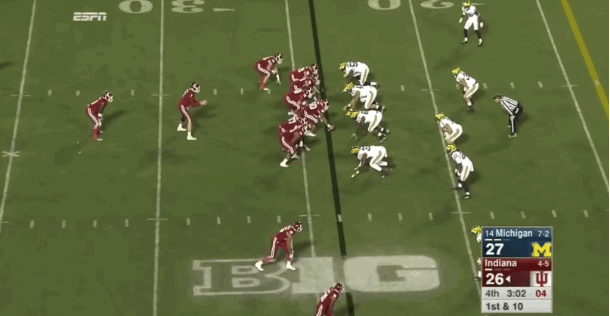
But the biggest weakness in the Michigan run defense has been against quarterbacks in the option game. Though not a track star by any means, Minnesota QB Mitch Leidner made some huge plays with his feet, thanks to the blocking advantage granted by the deep safety.
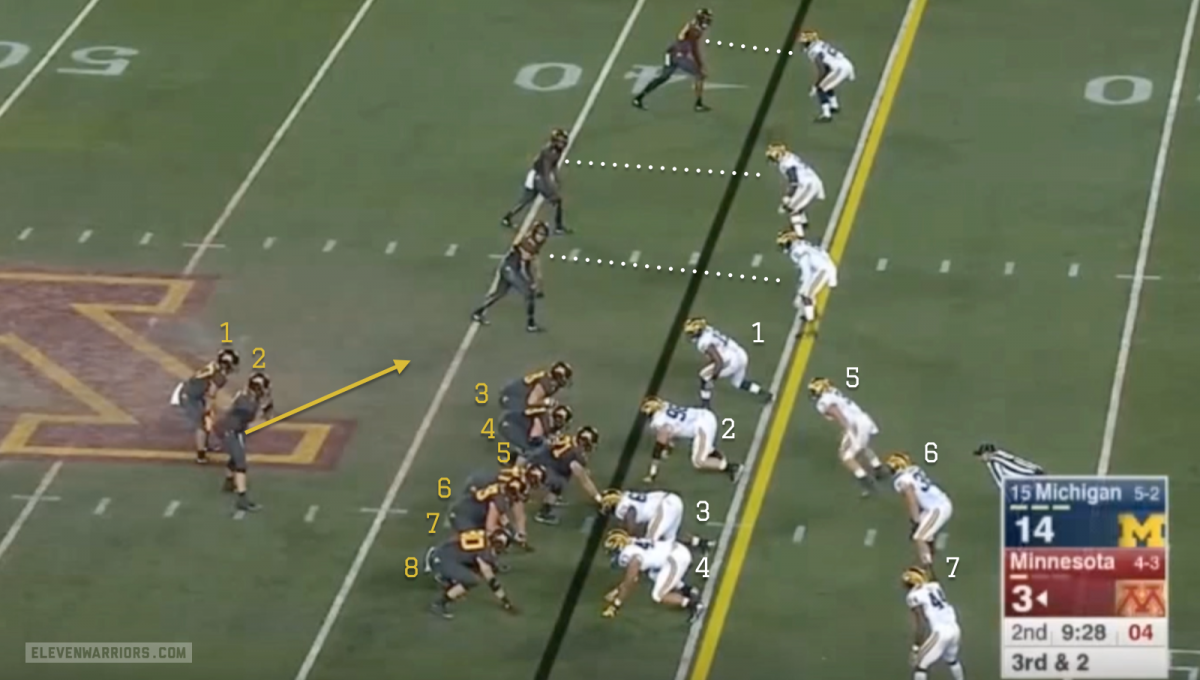
Knowing the Wolverines would line up man-to-man on the outside with the safety behind them, the offense would regularly have an extra blocker in the box. Alignments like this one were the reason the read-option was created, since a simple read from the quarterback should allow either he or the back room to run.

Ohio State quarterback J.T. Barrett will likely call his own number regularly on Saturday in Ann Arbor, knowing what a strong run game can open up through the air. Once the Michigan defense begins to give up yards regularly, they compensate by playing even more aggressively, which opens up easy yards in the passing game.

Perhaps since they expect the motioned receiver to be picked up by a defensive back in solo coverage behind them, Bolden and Morgan fly up at the fake handoff. The easiest way to beat man coverage is with crossing routes and slants, and the linebackers' aggressive play here gave the quarterback an easy target.
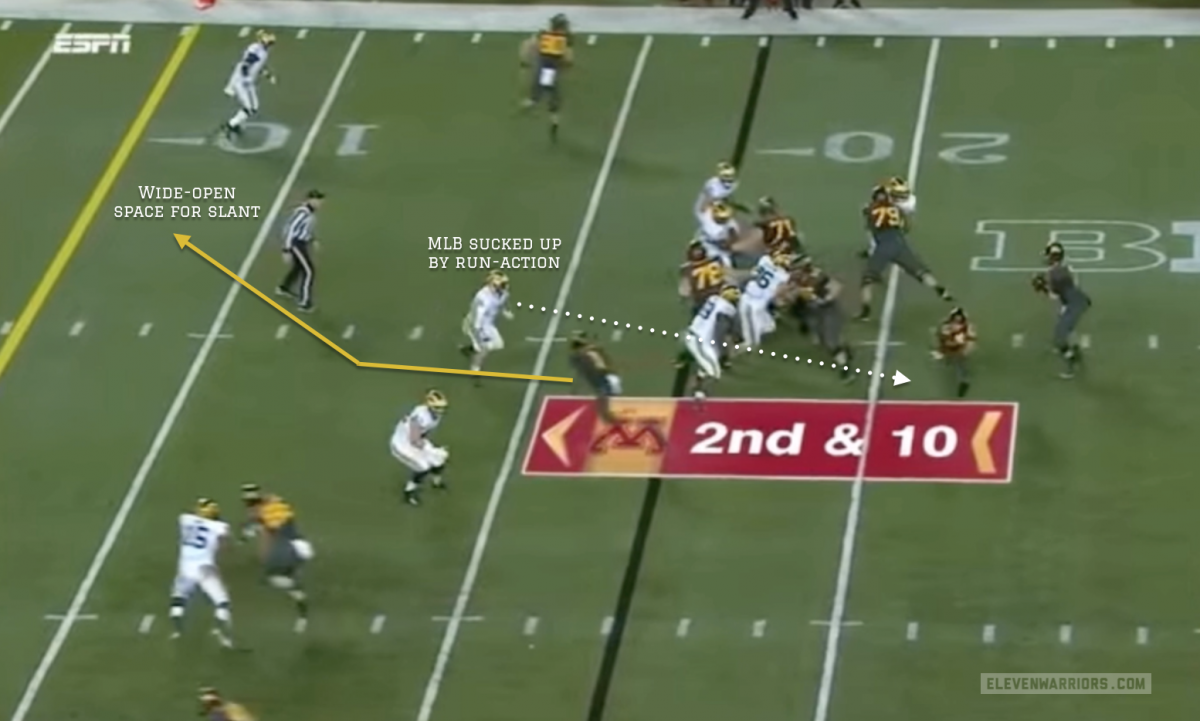
However, beating the Michigan defense through the air won't always be this easy, and the Buckeyes must pick and choose when to take their shots. Jourdan Lewis (#26) has emerged as one of the best cover-corners in the country with 19 pass break-ups so far this fall, and the battle between him and Michael Thomas will be one to watch on the outside.
But although there are some great athletes in the Michigan secondary, like Peppers, Lewis, and free safety Jarrod Wilson (#22), they're still learning the finer details of man coverage. Durkin often calls for a multitude of personnel and alignments in the secondary, and seeing a 'dime' package with six defensive backs isn't rare.
Although Durkin has implemented a number of complex, matchup-zone schemes thanks to this versatility, allowing the secondary to handle formations in which three receivers align to one side. But the back-side corner is often left to make a MEG (Man Everywhere He Goes) call in these scenarios, playing completely alone against the receiver on their side. With Lewis playing exclusively on the defense's right, the Buckeyes must isolate explosive receivers like Thomas, Jalin Marshall, and Braxton Miller against the lesser Michigan defenders on the left.
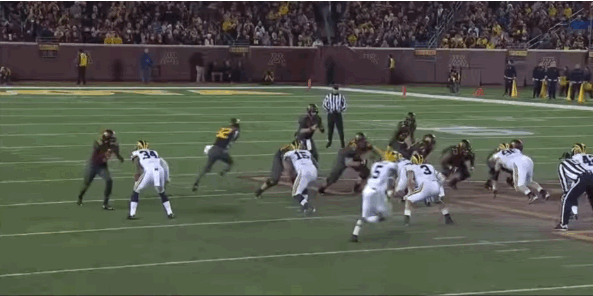
Additionally, Durkin's scheme often leaves linebackers alone in coverage against running backs that release in passing routes. With a back like Ezekiel Elliott (or even Curtis Samuel, should he line up there) that can reliably catch the ball out of the backfield, the Buckeyes could attack Morgan and Bolden with their athleticism by way of flare and wheel routes.
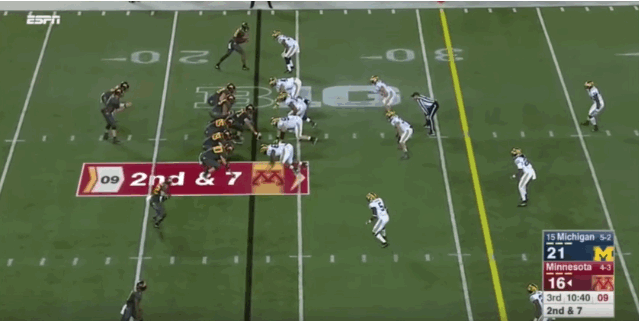
Knowing the secondary is exposed behind them, the Michigan defensive front has had to make plays in the passing downs. Even though they're without a star pass-rusher to rely on, the Wolverines have registered 29 sacks this season, forcing quarterbacks to get the ball out quickly with constant blitzes.
This unit offers a very different challenge to the OSU offensive line than the one brought a week ago by the Spartans, as the Buckeyes should be able to handle any of the Michigan defenders alone in pass protection. Yet identifying rushers has been the real challenge for their opponents this fall.
One of Durkin's favorite such schemes is to line up three down linemen in a 'Bear' front, forcing each of the interior offensive linemen to handle pressure up the middle. But more importantly, they're unable to help handle any of the twists or stunts that often come from the linebackers on the outside.
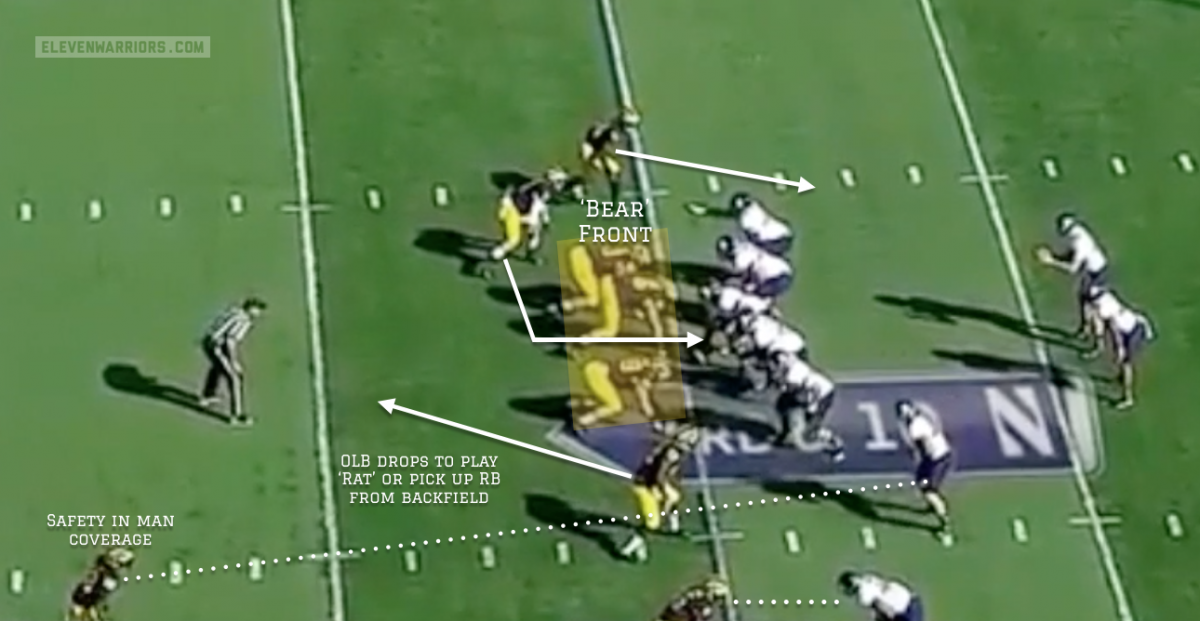
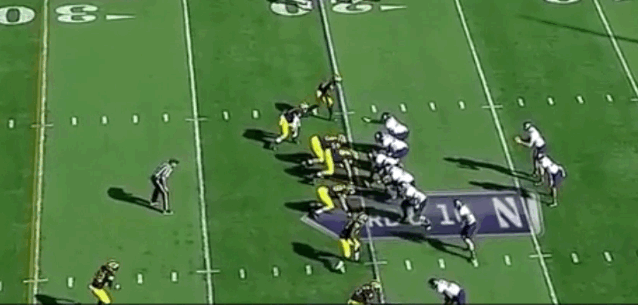
Communication along the Buckeye front will be key, and Barrett will have to identify his 'hot' receivers before every snap. He also must get the ball out quickly and decisively in these situations, as the Michigan secondary doesn't often call for confusing zone coverages in these situations. If Barrett's receiver has a step on his defender, the ball has to come his way immediately.
Durkin's defense has looked so good this year by often overwhelming their opponents with unfamiliar looks and schemes. Few teams in college football run this much man coverage, and even fewer have as many on-field adjustments as this unit does. The fact that they're rarely getting caught out of place is a testament to the entire coaching staff on that side of the ball.
But even with some NFL-caliber talent like Peppers and Lewis, the Buckeyes should have a clear advantage in talent on offense, and shouldn't try to out-scheme the Wolverines. Instead, they must rely on out-executing their opponents, something they failed to do last week against Michigan State.
Though former players often cite 'The Game' as being the most physical contest they've ever experienced, that should be a welcome sight for this OSU team. The Michigan defense takes enough risks that there will be plays for the offense to make, however it's on them to do so.
Durkin and the Wolverines have been standing toe-to-toe with each of their opponents this fall, and have often come out on top. Hopefully the Buckeyes will welcome the challenge.
